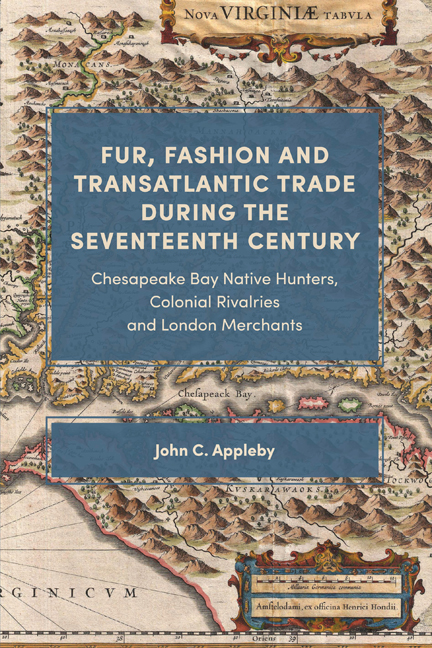 Fur, Fashion and Transatlantic Trade during the Seventeenth Century
Fur, Fashion and Transatlantic Trade during the Seventeenth Century Book contents
- Frontmatter
- Contents
- Acknowledgements
- A Note on Conventions
- Abbreviations
- Maps
- Introduction
- 1 Fur and Fashion: The Infrastructure of a New Trade
- 2 Commerce and Colonization: The Emergence of the Fur Trade in Chesapeake Bay
- 3 Trade and Rivalry: The Promise of Expansion and Innovation during the 1630s
- 4 Trade, Rivalry and Conflict during a ‘Time of Troubles’ from 1640 to 1660
- 5 Commercial Change and Conflict: Contrasting Experiences after 1650
- 6 Trade, Consumption and Industry: Transatlantic Constraints on the Bay Trade
- Conclusion
- Appendix
- Select Bibliography of Works Consulted
- Index
3 - Trade and Rivalry: The Promise of Expansion and Innovation during the 1630s
Published online by Cambridge University Press: 15 December 2020
- Frontmatter
- Contents
- Acknowledgements
- A Note on Conventions
- Abbreviations
- Maps
- Introduction
- 1 Fur and Fashion: The Infrastructure of a New Trade
- 2 Commerce and Colonization: The Emergence of the Fur Trade in Chesapeake Bay
- 3 Trade and Rivalry: The Promise of Expansion and Innovation during the 1630s
- 4 Trade, Rivalry and Conflict during a ‘Time of Troubles’ from 1640 to 1660
- 5 Commercial Change and Conflict: Contrasting Experiences after 1650
- 6 Trade, Consumption and Industry: Transatlantic Constraints on the Bay Trade
- Conclusion
- Appendix
- Select Bibliography of Works Consulted
- Index
Summary
In 1629 Sir George Calvert, first Lord Baltimore, visited Jamestown seeking a new refuge for a Catholic colony. A former Secretary of State under James I, Calvert resigned office following his conversion to Catholicism. During the early 1620s he established a small outpost on Newfoundland, where he settled with his wife and family in 1628. Defeated by the ‘sadd face of wynter’, he sought an alternative location in Chesapeake Bay. Robert Beverley subsequently noted that the settlers ‘looked upon him with an evil Eye, on account of his Religion’. Despite the hostile reception, on his return to England he secured royal approval for the creation of another colony in the Bay, named Maryland, in honour of Charles I's French wife, Henrietta Maria. Although Calvert died in April 1632, shortly before the charter for the settlement passed under the royal seal, his son Cecil, second Lord Baltimore, proceeded with the venture. By this ‘unhappy Accident’, bemoaned Beverley, a ‘Country which Nature had so well contriv’d for one, became Two separate Governments’. The establishment of Maryland transformed an emerging colonial world. It divided the Bay into rival colonies and competing interethnic trading associations and networks. At the same time the new colony threatened the prospect of colonial expansion in Virginia. Consequently, during the 1630s the Bay became a bitterly contested arena, where religious animosity inflamed the competition over trade and territory. The focal point for much of this rivalry was Kent Island, settled as a satellite of Virginia, but which after 1634 lay within the bounds of Maryland. Claiborne's ambitions to combine trade and plantation in the upper Bay were mirrored by those of the Maryland adventurers along the Potomac. Innovative schemes to develop the transatlantic trade in beaver skins thus occurred under challenging and competitive conditions. Colonial and native rivalries, which spilled over into Delaware Bay, fuelled commercial expansion, but from the outset there was a danger that these duelling ventures would frustrate the aims and ambitions of the other.
The Kent Island joint stock from 1631 to 1634
Although studied from various perspectives, the Kent Island partnership has yet to be recognized as one of the most ambitious and novel fur trading ventures established by the English prior to the formation of the Hudson's Bay Company in 1670.
- Type
- Chapter
- Information
- Fur, Fashion and Transatlantic Trade during the Seventeenth CenturyChesapeake Bay Native Hunters, Colonial Rivalries and London Merchants, pp. 85 - 130Publisher: Boydell & BrewerPrint publication year: 2021


